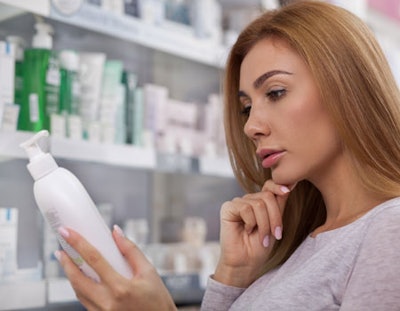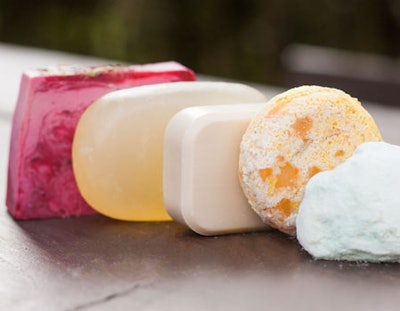
Clean beauty is something everyone is talking about without having ever settled on a universal definition of the concept. While the specifics may vary, most retailers, brands and even consumers appear to agree the key pillars of clean beauty include: safety, sustainability, ethics and transparency.
In attempt to decode this market phenomenon, let’s start with a quote: “[O]ur mission is to get safer products into the hands of everyone … ” The woman who said this is Gregg Renfrew, CEO and founder of Beautycounter. Beautycounter grew 27% between 2017-2018. And, in 2018, Beautycounter was the most searched beauty brand online in the U.S., generating $320 million in sales for the year, per NPD numbers. That makes it not only the largest digital-native brand, but also one of the top stand-alone brands in all of beauty.
The brand even sent reps to Capitol Hill last year to lobby Congress to act on preventing “harmful” ingredients from being used in beauty and personal care. This activism represents a growing embrace of the precautionary principle, which resists the introduction of ingredients, processes and products with unknown or disputed impacts.
This is the world view held by many consumers and upstart brands. And of course, it’s had an impact on Beautycounter’s manufacturing partners. Renfrew recently joked at a CEW event that her contract manufacturers had nicknamed the brand Brutal encounter; this is the new setting in which so many in the beauty industry find themselves.
 The growing reality is consumers want brands and retailers to deliver products that are thoughtfully designed to have the least possible negative impact on human health, the environment and society—as they, the shopper, define it, which no doubt rightfully rankles plenty of suppliers and chemists who are frustrated by the nuances and technical realities that are all too often lost in the conversation. But there are ways to use emerging green technologies, safe synthetics, consumer education and institutional technical know-how to find new paths forward.
The growing reality is consumers want brands and retailers to deliver products that are thoughtfully designed to have the least possible negative impact on human health, the environment and society—as they, the shopper, define it, which no doubt rightfully rankles plenty of suppliers and chemists who are frustrated by the nuances and technical realities that are all too often lost in the conversation. But there are ways to use emerging green technologies, safe synthetics, consumer education and institutional technical know-how to find new paths forward.
Free From 'Free-from'
What’s not in a product has become the focus of the beauty industry in recent years. In 2018, Google search data showed the top ingredient searches relating to safety in beauty included: sulfate, aluminum, parabens, silicone and alcohol (often rendered in searches for alcohol-free).
It’s no surprise, then, that data from Nielsen shows “free-from artificial fragrance” brand dollar sales rose 2% in 2018, compared with 0.1% for the total personal care sector. They now represent about 28.2% of the total market.
Meanwhile, retailer no-no lists provide a strong tool of trust-building and differentiation for retailers of all sizes. SpaceNK, for instance, states that clean beauty “refers to any formulation that is free from a list of potentially harmful and irritating ingredients, and instead uses a combination of plants, vitamins, minerals and botanical extracts to help restore skin to its optimum health and vitality.”
The company adds, “Clean also refers to products and brands that showcase a concerted effort to manufacture more consciously, whether it be recycled packaging or sustainable ingredients.”
At the same time, the Clean at Sephora program features products “formulated without SLS, SLES, parabens, formaldehyde, phthalates and mineral oils.” Qualifying products feature a Clean at Sephora sticker. These designations also serve to make it easier for consumers to determine which choices are “best” in an increasingly crowded marketplace filled with countless upstart indie brands.
But not all free-from claims are embraced equally by consumers. For instance, Nielsen data shows clean brands that eschew specific no-no ingredients and key artificial ingredients grew by 4.2% in 2018, compared with brands that merely declared themselves artificial-free, which grew by just 2.6% in 2018.
Another Nielsen report noted, “In our study … ‘free from’ claims didn’t stand out as much to consumers as some of the specific ingredient mentions, but overarching ‘free from harsh chemicals’ and ‘non-toxic ingredients’ themes were very believable to achieve various skin care benefits.”
Brands that operate in the EU have an added challenge: The latest update to the EU’s EC No. 655/2013 regulation now prohibits free-from claims as of July 1, 2019. The latest annex prohibits the use of free-from claims for ingredients prohibited by the EU Cosmetics Regulation (e.g., heavy metals); for formulations that are merely in compliance with the law; for ingredients that aren’t supposed to be present in the product; for products that leverage an ingredient for specific attributes (e.g., preservation or fragrance) without claiming those attributes (e.g., an aromatic material not claimed as a fragrance), unless that attribute is a side function of the general ingredient family; or for ingredients/ingredient families that are legally used.
There are instances where free-from claims will be allowed, including designations for vegan products (i.e., free-from animal-derived products).
Consumers want brands and retailers to deliver products that are thoughtfully designed to have the least possible negative impact on human health, the environment and society—as they, the shopper, define it.
The Case for Safe Synthetics
The beauty industry, just like the foods industry, has suffered from the false equivalency of natural with safety. However, in the age of veganism and safe ingredients, conventional materials have a role to play.
For instance, silicones are an inert, non-reactive technology that boosts the sensory impact of products without skin irritation. These materials also comply with the Clean at Sephora beauty standards. At the same time, consumers have real concerns about sourcing ethics when it comes to naturals, with palm oil and coconut oil often in the spotlight.
In fact, according to Mintel, 74% of Spanish beauty and personal care consumers are concerned that ingredients used in natural products are not sustainable.
Ethical and sustainability considerations have helped fuel the use of responsible synthetic options throughout the beauty industry. For instance, Mintel found synthetic beeswax appeared in 5% of global makeup launches in 2018, compared with 3% in 2014. Carmine launches dropped from 37% to 23% between 2013 and 2018. Cruelty-free makeup brushes with synthetic fibers are also on the rise.
Conventional chemistry can continue to play a role in improving the sourcing and sustainability ethics of the beauty industry and score points for sound science in the process.
Meet the Skintellectuals
The beauty industry may have an emerging ally in getting the word out about the benefits of cosmetic ingredients of all kinds. Skintellectuals are true beauty nerds. They’re hyper-knowledgeable about brands, products and ingredients and are probably least likely to utter the phrase “if I can’t pronounce the name, I don’t want it in my products.”
The skintellectual is the answer to the overwhelming anti-technological attitude found among a significant number of beauty consumers who prize natural above all else. These consumers understand why ingredients are included in products and can explain what, exactly, they do.
But they’re also demanding. They want formulas that work hard and deliver clinic-standard results at-home. These consumers can also be leveraged by marketers and savvy social media teams to advocate for science-based conversations about products that focus on safety, efficacy and value.
Go Blue or Go Home
Brands in the clean/sustainable space grew rapidly in 2018, including Tata Harper (38%), Kopari (66%) and Coola (59%), according to NPD data. Many brands have adopted green practices that focus on limiting harm to people and the planet, while offering transparency around ingredients and business practices. A subset of those brands have evolved further, pushing into what’s known as blue beauty, which seeks to avoid harm while also addressing or undoing damage from the past.
This blue mindset takes the form not just of zero waste, but also of generating negative carbon footprints. Companies operating in this space will leverage closed loop concepts, as seen with some packaging pilot programs under way with P&G, Unilever and others, in addition to upcycling concepts, reusable technologies, truly recyclable materials that won’t ultimately end up in a landfill, and, interestingly, focusing on boosting the economic well-being of a wider swath of society.
This is a radical idea, but given the wealth gap in this country, brands that seek to close the distance with programs that benefit local communities at home and abroad might find a receptive audience.
This activity, paired with transparency, has a payoff. According to NPD data, 78% of consumers trust transparent brands more than conventional companies, while 73% are willing to pay more for products from transparent brands.
Behind the demand for natural ingredients is the consumer's genuine concern for safe products.
Go Naked!
One way for brands to transition to the blue economy is to formulate their way out of packaging. Interestingly, clean beauty formulas often require rigorous packaging to minimize risk of harming formulas with limited preservation systems, but other trends are shaping behaviors as well.
 In the age of e-commerce, packaging will test clean beauty brands’ technical and design resources to deliver products safely without excess. Lush’s Naked range, for example, represents the next phase of product innovation: zero packaging. The formulation comprises murumuru and cocoa butter, and strawberry and orange puree. The Naked product range includes solid shampoos and bath bombs as well. The brand has also opened its first packaging-free storefront in the United Kingdom.
In the age of e-commerce, packaging will test clean beauty brands’ technical and design resources to deliver products safely without excess. Lush’s Naked range, for example, represents the next phase of product innovation: zero packaging. The formulation comprises murumuru and cocoa butter, and strawberry and orange puree. The Naked product range includes solid shampoos and bath bombs as well. The brand has also opened its first packaging-free storefront in the United Kingdom.Meanwhile, HiBar has launched a salon-quality shampoo and conditioner bars created with no plastic or sulfates, eliminating the need for single-use plastic packaging, according to the brand. The products are available in clarifying, moisturizing and volumizing formulas that have been designed to stand up in the shower, shed moisture and offer an ergonomic experience and ease of application. That said, the product still has secondary cardboard packaging. The challenge continues...
Label to Lab: 7 Strategies
What does “clean beauty” mean from a technical standpoint? The foods industry started it, with the “clean label” movement. Driven by consumers, it meant omitting artificial flavors and colors; minimizing additives that modify texture or taste; and ultimately shortening ingredient lists to the essentials—especially those with natural and familiar-sounding names. Think: Breyers ice cream, which markets its use of “simple and pure ingredients,” and even calls out its natural vanilla ice cream recipe of five ingredients: milk, cream, sugar, vegetable gum and natural flavor.
Similarly driven by consumers, clean beauty follows many of these same tenets: removing unnecessary ingredients and using naturals wherever possible. In fact, by most accounts, “clean beauty” is an iteration of the blockbuster naturals market, although with a heavier focus on safety, for both the user and environment; efficacy, meaning products that actually work and feel nice; and transparency for what’s in a product as well as where it came from.
To formulators, this translates roughly into seven areas of focus for developing products that fit the “clean beauty” mindset; note that one or all of the following concepts may be employed in the same formula.
1. Simplified Formulas
“Simplified formulas” can mean a few things. To consumers, it’s about shorter ingredient lists on a product label. To formulators, this could mean leveraging multifunctional materials; and suppliers have designed many to choose from. It also could mean formulating smarter, to utilize ingredient synergies. This skill typically comes from experience.
Simpler formulas also mean going back to basics—especially with natural or botanical ingredients since these are perceived as “untouched” and “pure.” Marketing has impressed upon consumers “if you can’t pronounce an ingredient, you likely don’t want it in or on your body.” As such, naturals are also generally familiar and more approachable to consumers.
The bottom line for a simplified formula is: strip it down to the basics. Each ingredient must have a purpose in the formula.
2. Naturals/Botanicals
Continuing with the consumer preference for naturals, not only are these ingredients praised for their purity (regardless of the GC-MS readings), but they also are viewed as safer. Whether or not this proves to be the case, there are ways to process natural ingredients to bring this belief closer to reality.
One is through the use of techniques such as supercritical fluid extraction, as this derives the desired natural extract without the use of undesired synthetic solvents, which even at trace levels, can be irritating to some users. Another is to concentrate and derive only the desired phytochemical constituents from naturals, which can be achieved through a technique known as zeta fractioning.
Not only does this advanced technique target specific entities in the plant, it also concentrates them for higher efficacy. And as mentioned above, even though a product fits the “clean label” mindset, consumers have an expectation that it will work just as well and feel just as good as any other product on the market. As such, additional approaches to incorporating naturals may include the use of natural and synthetic blends, to obtain desired performance and sensory profiles.
Ethical and sustainability considerations have helped fuel the use of responsible synthetic options throughout the beauty industry.
3. Responsibly Sourced
“Clean beauty” also means a clean conscious. As an extension to the naturals demand, this may refer to ingredients that are Fair Trade- and Fair Trade for Life-certified, which ensures the farmers, workers and communities of people involved in cultivating the supply chain are supported from an economical as well as ethical standpoint.
There are many questions to consider as you choose ingredients. For example: Does the ingredient supplier invest in the supply chain community? Do the local farmers have health care? Do their children have access to education? Are concessions made for Mother Nature, i.e., when it’s a bad year for crops?
Furthermore, is the supply chain traceable? When consumers purchase based on these ethical considerations, can the product be validated as such? Are measurement tools in place? And are the products coming from the same, consistent source—with natural ingredients, the variability of growth conditions is an important factor influencing the phytochemicals present in the plant.
 Are the ingredients sourced and processed in consideration of the environment; i.e., how large is their carbon footprint? Could solar or wind power support their processing? Does sourcing the natural ingredient align with biodiversity tenets? For example, the Nagoya Protocol, which protects the use of genetic materials, including plant DNA, so that resources are conserved and all may equally benefit from them.
Are the ingredients sourced and processed in consideration of the environment; i.e., how large is their carbon footprint? Could solar or wind power support their processing? Does sourcing the natural ingredient align with biodiversity tenets? For example, the Nagoya Protocol, which protects the use of genetic materials, including plant DNA, so that resources are conserved and all may equally benefit from them.And in the same vein, are the natural ingredients sourced sustainably? In some cases, to avoid depleting the native supply, biotechnology techniques are used to collect plant stem cells and maintain them in culture, which can then be extracted for use. Another approach is to employ fermentation processes, to output specific metabolites for product applications.
Waterless product formats and upcycled ingredients are additional options aligning with responsible sourcing. With growing concerns over water scarcity, waterless formulas allow consumers to control their water use; they also reduce the amount of weight being shipped cross country, saving on fuel and carbon footprint. And upcycled ingredients, such as spent coffee grounds, can be used to derive cosmetic extracts. These are the epitome of reusing and recycling, which feeds into the greater circular economy.
A completely different approach—if you can convince Marketing—is to side with the science and choose the best, safest and most effective ingredient for the job, then be transparent by disclosing it on the product label.
4. Safe for the User
Behind the demand for natural ingredients (and clean beauty) is the consumer's genuine concern for safe products. Users rightfully expect non-irritating and non-toxic products; although a barrage of readily available misleading and misinformation has confused them about what exactly that means. Research taken out of context, flawed or irrelevant study designs and even the industry itself, with its free-from antics, have perpetuated the cycle, leading formulators with a limited number of options.
How often do formulators face a marketing brief requiring ill-perceived ingredients to be omitted? Do they formulate for consumer beliefs, regardless of the science? Or do they advocate for the proven safety and efficacy of those misunderstood ingredients, including preservatives, silicones, etc.? And educate consumers about exposure rates and routes, or the incorrect assumption that D4, D5 and D6 are the same material?
One camp in clean beauty strongly supports the former, and Sephora has taken the lead by outlining for consumers what specific ingredients are "undesirable” by stamping its seal on products whose labels pass the test. Specifically, the “Clean at Sephora” approval goes to products that do not contain: SLS, SLES, parabens, formaldehydes, formaldehyde-releasing agents, phthalates, mineral oil, retinyl palmitate, oxybenzone, coal tar, hydroquinone, triclosan and triclocarban.
It's not quite clear what parameters were used to draw up the list but the website explains, "We scoured the scene, met with brand founders and experts, and asked you exactly what you’re looking for in clean beauty."
A completely different approach—if you can convince Marketing—is to side with the science and choose the best, safest and most effective ingredient for the job, then be transparent by disclosing it on the product label.
5. Safe for the Environment
Clean beauty also encompasses safety for the environment. This means formulating with ingredients that are biodegradable, safe to aquatic and other life forms, and do not persist in the environment. Greener chemistries are designed to this end, and supplier companies supporting this tenet will often perform a cradle-to-grave ingredient analysis, to understand a material’s outcome not just during, but after it has been used and released into the environment.
In relation, ingredients with questionable outcomes in the environment should, preferably, be omitted under clean beauty tenets and substituted with alternatives; for example, cellulose in place of PVP microbeads. In fact, in some instances—regardless of the science—the omission of questionable ingredients is mandatory; take the recent cases of Hawaii and the Florida Keys and their bans on inorganic sunscreens as an example.
Inconclusive science based on questionable study designs suggested these materials were harming coral reefs. Yet, responding to consumer alarm, regulators jumped to action to ban these ingredients; but this raises further issues. Considering these are perhaps the best sunscreens available in the United States to protect consumers from UV, it seems the health of the coral reefs took precedence over consumer safety.
Turning back to the question of clean beauty in context of the environment, again, sustainable sourcing must be ensured so as not to deplete the natural supply. In addition, the clean beauty consumer prefers pesticide-free, organic ingredient cultivation and processing, so as to prevent introducing possible toxins or pollution into the environment.
6. Effective
Beyond all the parameters outlined above, consumers hold certain performance expectations for products. No longer are cosmetics purchased based solely on their natural label claim; they are expected to perform. As such, formulators must ensure clean beauty products delivery on efficacy as well as sensory properties.
As the late Johann Wiechers described it, in his “Formulating for Efficacy” approach to product development, each ingredient in a product should included for a purpose. Furthermore, if an ingredient is intended to have an activity, it must be delivered effectively to the body site and made bioavailable so it can perform.
7. Transparent
Finally, regardless of the tactics you take to formulate clean beauty products, it’s important to clearly communicate the contents of a product on its label. This empowers consumers to purchase based on truth, closing the product cycle with their belief in your product.











